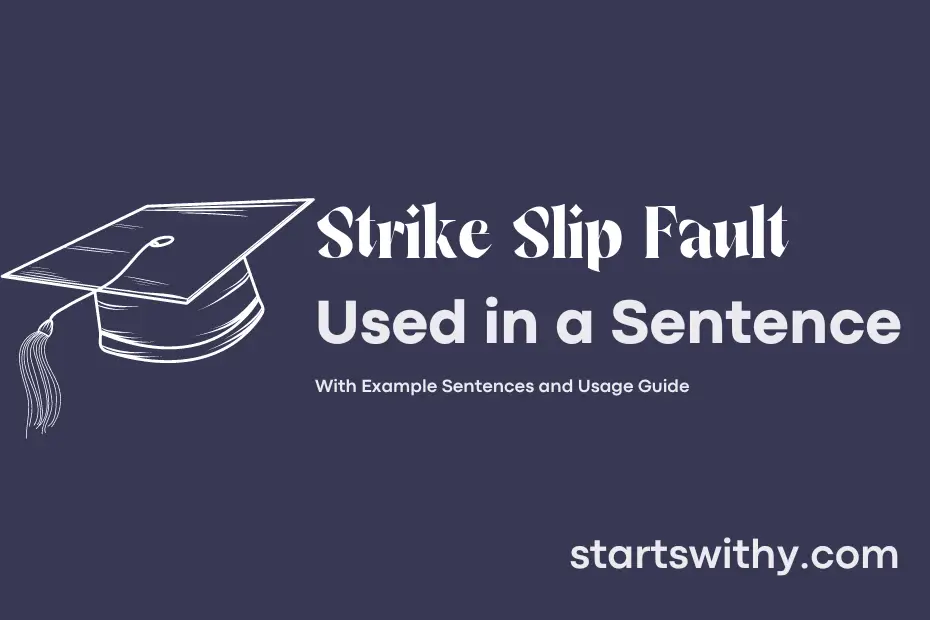Have you ever wondered what a strike-slip fault is? In geology, a strike-slip fault is a type of fault where rocks on either side move past each other horizontally.
These faults are caused by horizontal shear forces that result in lateral movement along the fault line. This movement can occur swiftly or gradually, depending on the stress buildup along the fault.
7 Examples Of Strike Slip Fault Used In a Sentence For Kids
- Strike slip fault is a type of fault in the Earth’s crust.
- The strike slip fault causes rocks to move sideways.
- Earthquakes can happen along a strike slip fault.
- Scientists study the movement of rocks along a strike slip fault.
- The San Andreas Fault is a famous strike slip fault in California.
- Sometimes, a strike slip fault can cause a lot of shaking on the ground.
- It’s important to learn about strike slip faults to stay safe during earthquakes.
14 Sentences with Strike Slip Fault Examples
- Strike-slip faults are common in regions where tectonic plates are sliding past each other horizontally.
- Understanding the mechanics of a strike-slip fault is crucial for geology students studying plate tectonics.
- The San Andreas Fault in California is a famous example of a strike-slip fault.
- A field trip to a site with a visible strike-slip fault can provide valuable hands-on learning for students.
- The movement along a strike-slip fault can cause earthquakes with a horizontal component.
- Geophysics students use various methods to study the characteristics of a strike-slip fault.
- A detailed geological map can help visualize the location and orientation of a strike-slip fault.
- Seismic activity monitoring stations play a significant role in detecting movements along a strike-slip fault.
- Geosciences students may analyze the rock formations adjacent to a strike-slip fault to understand its history.
- Interpreting the stress and strain patterns around a strike-slip fault is a key aspect of structural geology studies.
- A case study involving a recent earthquake along a strike-slip fault can provide valuable insights for students.
- Collaborating with other students to create a 3D model of a strike-slip fault can enhance understanding of its structure.
- Advanced remote sensing techniques can help identify subtle surface features associated with a strike-slip fault.
- Conducting a virtual field trip using digital maps and satellite imagery can enhance students’ understanding of a strike-slip fault.
How To Use Strike Slip Fault in Sentences?
To use a Strike Slip Fault in a sentence, you must first understand what it is.
A Strike Slip Fault occurs when two blocks of rock slide horizontally past each other due to shearing forces.
Here is an example sentence incorporating the term:
“The San Andreas Fault in California is a well-known example of a Strike Slip Fault that has caused devastating earthquakes.”
When writing a sentence with Strike Slip Fault, make sure to provide context so that the reader can understand how it is being used.
Additionally, it is important to note that Strike Slip Faults are classified based on the direction of movement of the rocks on either side of the fault.
Remember to use the term accurately and appropriately in your sentence so that your message is clear and concise.
By following these guidelines, you will be able to effectively incorporate the term Strike Slip Fault in a sentence with confidence.
Conclusion
In conclusion, strike-slip faults are a type of fault where the movement is predominantly horizontal, causing the rocks on either side to slide past each other. These faults are characterized by a vertical fault plane along which the movement occurs. For example, “The San Andreas Fault in California is a well-known strike-slip fault.”
The distinctive feature of strike-slip faults is their side-to-side motion, which can be seen in seismic activity and surface features. “The movement along the fault line of a strike-slip fault can cause earthquakes and offsetting of geological features.” Understanding the characteristics and behavior of strike-slip faults is crucial for assessing seismic hazards and ensuring the safety of communities located near these fault zones.



